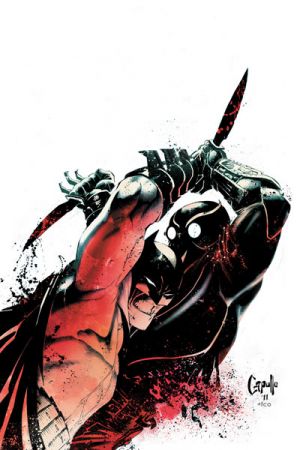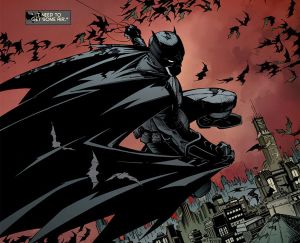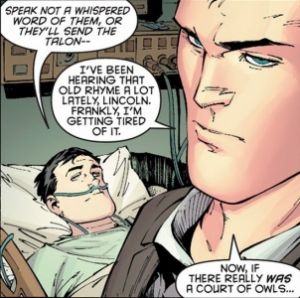Comics /
Spotlight /
Progressive Panels
Scott Snyder’s Batman
By Andy Frisk
December 6, 2011 - 21:18
“Historically, cities are places of superstition. After all, people come to them from all over the world, from small towns and villages, places they’ve lived for generations, to inhabit giant mazes of glass and steel, shadow and merciless light. They’d cling to beliefs from home about what keeps you safe, and what to avoid. A black cat crosses your path, you’ll be plagued by bad luck. A thirteenth guest at dinner means someone in the party will die at midnight. My great-grandfather, Alan Wayne, understood the power of superstition. As such, he was one of the first men to eliminate a thirteenth floor from his buildings. Funny thing though. To really make good on the superstition, you were supposed to leave a small space in the building between floors twelve and fourteen, a fake floor, to contain the bad luck of number thirteen. A space sealed off from the world, inaccessible. Just a blank slot in the building. An absence like a breath held when passing a graveyard. A space just big enough—in theory—for a man to hide in. Perhaps a killer dressed like an owl. And on the subject of owls, here’s a fact about them. They’re one of the rare birds that doesn’t build its own nest. Instead what they do is find nests abandoned or in use by rival birds and take them over. In essence, they invade an enemy’s territory…”
-Batman in Batman #3
No, The New 52’s Scott Snyder penned
Batman series isn’t published in novella form, but from the quotation above one might get the impression that it is, and it is a fantastic thing for a monthly comic book to be mistaken for reading like a novella. I don’t know Scott Snyder. I’ve been lucky enough to chat via email with him over his equally fantastic
American Vampire series, and have been following his work since
The Human Torch Comics 70th Anniversary Special, but nothing beyond that. Sometimes though you can get to know a writer through his work, and I can say with some literarily critical insight that Scott Snyder is a brilliant raconteur and a sharp literary mind with an eye for storytelling that’s rich with historical insight and theme. One only has to read his current work on
Batman to discern this.
In issue #3, Batman continues to research the seemingly new and mysterious threat to Gotham, The Court of Owls, and its agent of action, a character dressed like an owl with almost as many tech enhancements as Batman himself. As he discovers the owl’s several hidden residences spread throughout Gotham, it seems that the court has been active for much longer than Bruce Wayne/Batman was originally aware. Bruce’s great, great grandfather knew something about the court although his paranoia was chalked up to senility. He was right though, and the court of owls and their agent are more deadly, and influential, than Bruce could have imagined…
For the first time in quite a while, DC Comics’ readers like myself, are finally feeling like we are getting our money’s worth from titles like
Batman and
Superman in the aspect that they are not only packed with great art, but great dialogue and story that isn’t relying on a mega-crossover or gimmicky storyline, a la
Batman RIP, to drive it (That is for the most part:
Superman is
meandering a bit.) As far as
Batman is concerned, this is due to Scott Snyder’s sharp storytelling and ability to invest a tale (that really isn’t necessarily groundbreaking--Snyder is a great storyteller, not a perfect one) with powerful gravitas through his historically laden and thick application of legend, lore, and metaphor to weave an interesting story and concept villain for Batman to engage. It’s a villain and concept that is worthy of not just Bruce Wayne/Batman’s advanced fisticuff talents and Bat-gadgets, but his keen mind as well. Snyder has managed to capture the lighting in a bottle that characterized what Christopher Nolan did for Batman on the big screen. Snyder has been able translate it into comic book form in a way that makes
Batman a comic book worthy of being read by the intelligent fans of Nolan’s Batman. This is no small feat, especially since Snyder slightly improves on the type of realistic storytelling that Nolan
reinvigorated the Bat-franchise with. Snyder does so by using the written aspects of comic book storytelling to expound upon the “Nolan Theme,” as I call it, by adding his specific eye for, and interest in, weaving historical metaphor and reference into his story. This enriches the story reading experience by allowing Snyder to develop new myths surrounding the already weighty Bat-franchise myth, as well as allowing Snyder to compose his unique brand of prose poetry.
Words and story are only half of a comic book story though, and Snyder’s paring with Greg Capullo is perfection. Dense and intricate storytelling requires equally dense and intricate art to bring it to life in sequential art form. Capullo composes the necessary visual poetry needed to compliment Snyder’s poetic prose. Detail, body language, action choreography, and a realistic setting and background characterize Snyder’s
Batman perfectly. Even when Capullo resorts to the stock in trade Batman symbolism, like Batman in his Bat-glider crossing the moon, thusly creating a highlighted “Bat-signal” image, it looks fresh, new, realistic, and archaic all at once, just as it should. He also has a keen eye for recreating real world historical period dress, technology and imagery. This is incredibly necessary when illustrating a Scott Snyder tale. His darkly atmospheric pencils, when beautifully inked by Jonathan Glapion and colored brilliantly by Eco, compete the unique artistic experience that is
Batman.
Scott Snyder’s storytelling really is the future of DC Comics right now. While DC Comics has some other great talent, namely in Bill Willingham and Jeff Lemire, Snyder really is becoming the flagship writer there by doing so many really great things with DC Comics’ hottest property (another of my personal favorites, Sterling Gates, is being wasted by being paired with Rob Liefeld on
Hawk and Dove—although I hope Gates can get his magic working there, even with the difficult pairing and subject). Snyder’s got his plate full with
Batman,
American Vampire,
Swamp Thing, and his creator owned works like
Severed over at Image Comics, but still manages to turn in quality work on all of them. He sets the example for other great comic book storytellers out there who struggle with juggling multiple projects and supplying readers with consistent quality, something Marvel Comics’ new young gun, Jonathan Hickman, is having trouble doing. I think we’re going to be hearing from, reading about, and enjoying the work of Scott Snyder for some time to come.
Like music? So does Andy. Read his thoughts on it
here.
Last Updated: January 17, 2025 - 08:20


